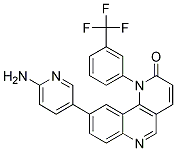All AbMole products are for research use only, cannot be used for human consumption.

Torin 2 is a potent and selective inhibitor of cellular mTOR activity (EC50 = 0.3 nM). Torin 2 inhibits mTORC1, thus activates TFEB by promoting its nuclear translocation with EC50 of 1.666 mM. Torin 2 displays more than 800-fold selectivity for mTOR over PI3K (cellular EC50 values are 0.25 and 200 nM for mTOR and PI3K respectively) and greater than 100-fold binding selectivity relative to 440 other protein kinases. Torin 2 has significantly improved bioavailability (54%), metabolic stability, and plasma exposure compared to Torin 1. Torin 2 exhibits >95% pharmacodynamic response and half-time of 11.7 min in the mouse liver microsome stability study in vivo.
| Cell Experiment | |
|---|---|
| Cell lines | MZ-CRC-1 and TT cells |
| Preparation method | Cell viability and motility assays For viability, MZ-CRC-1 and TT cells were seeded in quadruplicate in 96-well plates (10,000 cells per well) in culture media with 2.5% and 4% FBS, respectively. After 24 hours, cells were treated with the indicated compounds. At the indicated time point, cells were incubated for 3 hours with 10 μL of CellTiter96 AQueous One solution in 100 μL of culture media and absorbance was measured at 490 nm. For migration assays, Transwell inserts with membranes of 8 μmol/L pore size were used. Membranes were coated with 10 μg/mL collagen and kept at 4°C overnight. Cells were serum starved for 8 hours, detached by trypsin, and counted by hemocytometer. A total of 1 × 10^5 cells were plated in the upper chambers in serum-free medium, containing the vehicle or the indicated compounds (rapamycin: 100 nmol/L; everolimus/Rad001: 100 nmol/L, and Torin 2: 100 nmol/L). The lower chambers were filled with MZ-CRC-1 and TT culture media containing 2.5% and 4% FBS, respectively, supplemented with 20 ng/mL EGF. After 24 hours, cells were fixed in methanol and stained with hematoxylin. Cells on the top surface of the membranes were wiped off with cotton swabs. Membranes were removed from the inserts, placed on microscope slides, and images acquired by Scanscope. Migrated cells were counted and the number of migrated cells per mm2 was calculated. |
| Concentrations | 10, 50nM |
| Incubation time | 5 days |
| Animal Experiment | |
|---|---|
| Animal models | Six-week old male C57BL/6 mice model |
| Formulation | 100% N-methyl-2-pyrrolidone and then diluted 1:4 with sterile 50% PEG400 prior to injection |
| Dosages | 20 mg/kg for 6h |
| Administration | oral gavage |
| Molecular Weight | 432.4 |
| Formula | C24H15F3N4O |
| CAS Number | 1223001-51-1 |
| Solubility (25°C) | DMSO 10 mg/mL |
| Storage |
Powder -20°C 3 years ; 4°C 2 years In solvent -80°C 6 months ; -20°C 1 month |
| Related mTOR Products |
|---|
| RMC-4627
RMC-4627 is a selective mTORC1 inhibitor that activates 4EBP1 and inhibits tumor growth. |
| RMC-4529
RMC-4529 has an IC50 value of 1.0 nM against p-4E-BP1-(T37/46) in mTOR kinase cellular assay. |
| WYE-687 dihydrochloride
WYE-687 dihydrochloride is an ATP-competitive mTOR inhibitor with an IC50 of 7 nM. |
| Rapamycin-d3
Rapamycin-d3 |
| L-Leucine-d10
L-Leucine-d10 |
All AbMole products are for research use only, cannot be used for human consumption or veterinary use. We do not provide products or services to individuals. Please comply with the intended use and do not use AbMole products for any other purpose.


Products are for research use only. Not for human use. We do not sell to patients.
© Copyright 2010-2024 AbMole BioScience. All Rights Reserved.
